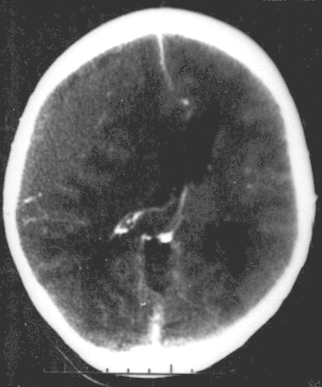Spanish
hematoma extradural Catalan
hematoma extradural 
Type of traumatic brain injury in which a buildup of blood occurs between the dura mater and the skull.
Synonyms
Examples for "epidural cranial hematoma"
Examples for "epidural cranial hematoma"
1
We report a 56-year-old man, with atypical presentation of an extradural hematoma caused by head injury after a fall.
1
A case of extradural haematoma as the presenting feature of an arachnoid cyst is described.
2
Eighty-two cases of extradural haematoma were analysed to elucidate the factors contributing to delay in treatment and poor outcome.
3
We present a series of seven patients with extradural haematoma operated upon in the referring hospital prior to transfer to our unit.
1
A rarely reported complication is skull fracture at the pin site and consequent epidural hematoma.
2
Complications of SMT are reviewed, and the etiology and features of spinal epidural hematoma are discussed.
3
This case represents the first spinal epidural hematoma occurring after a chiropractic manipulation in the lumbar region.
4
Subarachnoid hemorrhage was mostly absorbed within one week while epidural hematoma was completely absorbed over 3 weeks.
5
T2-weighted coronal MRI can diagnose both patency of the sigmoid sinus and epidural hematoma extending along the sinus groove.
6
We present two patients who had acute paraplegia with sensory loss due to spontaneous spinal epidural hematoma (SSEH).
7
The dura mater is checked for epidural hematoma-pooled blood that may have pressed on the brain and resulted in death.
8
Results: Neurological morbidity was observed in 1 animal and was attributable to the presence of a resolving epidural hematoma noted at necropsy.
9
The authors report the case of a 64-year-old woman who experienced thoracic epidural hematoma during a session of spinal manipulation therapy (SMT).
10
She underwent a bilateral C5-T6 laminectomy with epidural hematoma evacuation and was discharged to an acute inpatient rehabilitation hospital.
11
The New York City medical examiner's office said Richardson suffered from an epidural hematoma, which causes bleeding between the skull and the brain's covering.
12
Spinal epidural hematoma (SEH) is a rare complication with a reported incidence ranging from 1.38 in 10,000 to 1 in 190,000 epidurals.
13
Epidural fistulas are uncommon and rarely symptomatic, and when they are, it is usually from an epidural hematoma or mass effect from distended epidural veins.

